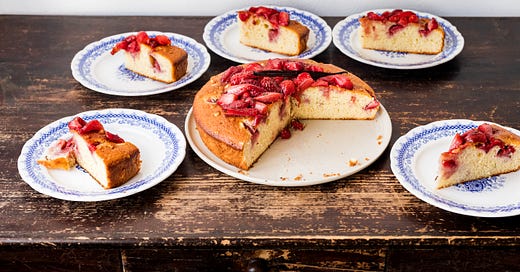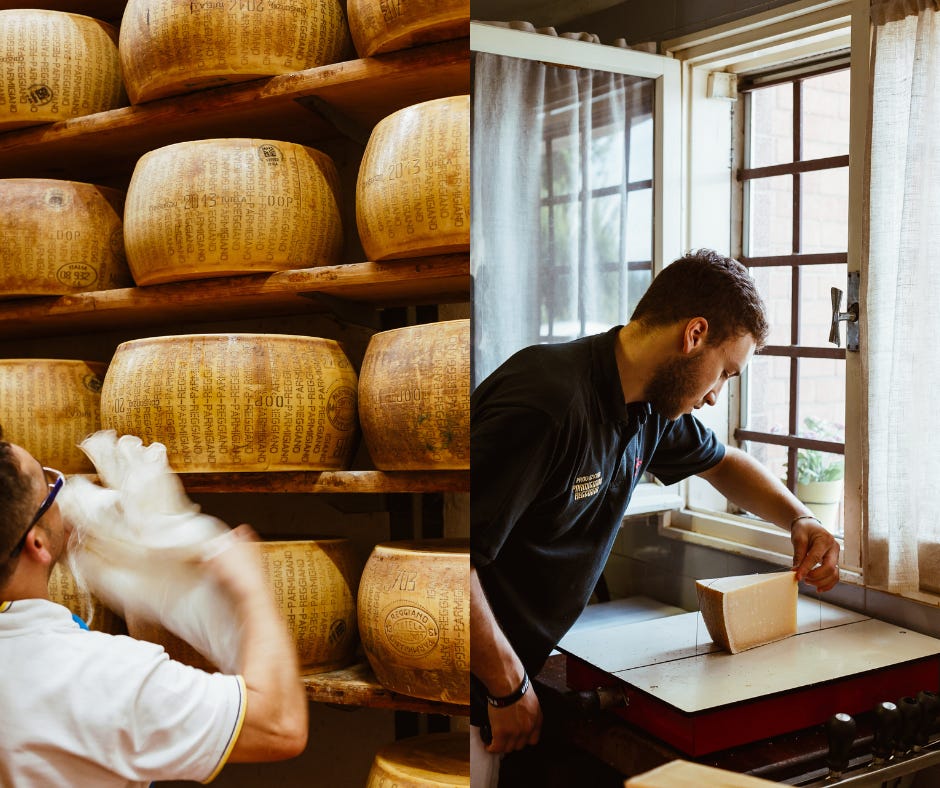What it means to go dairy free for an Italian (that would be me)
plus a recipe for a olive oil cake with roasted strawberries, where every mouthful is a song sung in praise of spring, the sweetest of seasons.
Just before Christmas I discovered I had to go permanently dairy free.
This diagnosis came after three years of tribulations, one of the pieces of a bigger puzzle that I’m still trying to solve, and that also involves heartburn, fatty liver, and gallstones. (Thank you in advance for your concern, I am followed by a competent doctor, so I don’t need medical advice). When I finally started listening to my body, I heard it whispering: stay-away-from-cheese!
My doctor told me it was better if I could avoid dairy altogether, even though during cooking classes or when I cook for my friends I am allowed to use lactose free products—but consider this as an exception!— This means that I should also stay away from Parmigiano Reggiano and Pecorino Romano, that are notoriously lactose free for their production system and aging process.
Initially, it didn’t come as a shock—my first fear was that I had to go gluten free—until I realized how ingrained in my Italian diet dairy is.
A croissant with pastry cream at the bakery in the morning; caffè macchiato as first option when ordering an espresso at the bar; nibbling on wedges of pecorino cheese drizzled with honey during an aperitivo; showering my pasta al pomodoro with grated Parmigiano; building a meal around the most perfect bloomy rind goat cheese; using sheep ricotta as a stuffing for ravioli, savory cakes, crostate and pies, or piling shelled fava beans on a crostone topped with some lemony ricotta; celebrating summer with a stroll and a gelato; holidaying in Salento, peppering my stay with meals revolving around burrata, stracciatella, rustici, and the freshest mozzarella, still oozing milk. Gosh, I will miss all of this.
Now I am one of those sophisticated people asking for orzo macchiato con latte di soia in tazza grande at the local café: a barley coffee stained with a drop of hot soy milk in a large cup.
As a cold comfort, Tommaso and my mum also tested lactose intolerant. I thought my mum would be the most difficult one to persuade to go dairy free (she asked the doctor if she could still drink her milk with coffee in the morning, solo quello, just that), but she surprised everyone by embracing oat milk.
Tommaso, however, is a different matter. He has never been on a diet before, and I find him occasionally sneaking a few slices of leftover pecorino cheese after a cooking class, or, for example, I had to constantly remind him that the beautiful cakes at the agriturismo breakfast buffet we visited for Easter were made with butter.
When I broke the news to my Italian friends, most of them were frankly appalled, way more than me.
No, I simply couldn’t do it. Even though dairy makes me feel bad most of the time, I can not turn away from cheese. Take away my cheese and I’ll die. I’m so sad to hear it, I hope it will pass soon.
And I get it, because culturally, I will miss it.
As I’ve written in the introduction to the Milk and Cheese chapter in Cucina Povera:
“Cheese is one of Italy’s most renowned products, exported worldwide and a sublime example of what “made in Italy” truly means. (…) What contributed to the negative reputation of dairy products—the taste and the smell—is what now makes cheese one of the most exquisite Italian foods. Cheese is an element of territorial and cultural identity, be it a rich cow’s-milk cheese made in an Alpine malga (hut), a sharp pecorino from the countryside outside Rome, or a milky buffalo mozzarella from Campania. It is not just their taste or texture, or how they are consumed: dairy products are a concentration of the culture, traditions, and history of a region in edible form.”
Instead, when I mention to my international guests during cooking classes that I cannot eat that luscious green fava bean and pecorino salad, or those plump ricotta tortelli with brown butter and sage, I am always received with an understanding nod. Yes, they feel sorry for me, but it is no big deal for them, as there are other options. And they pass me the focaccia.
When it comes to cooking, luckily I’ve always relied on extra virgin olive oil.
I was born in the land of olive trees, in that part of Italy that chooses olive oil rather than butter as primary cooking fat. I worship extra virgin olive oil: I cook with it, drizzle it lavishly over salads, soups, crostoni, and gelato, too. I fry with it, and bake with it.
In my go-to recipe for risotto with vegetables, for example, I use olive oil to shallow fry the onions until translucent. Lately, though, I’ve been experimenting with ghee—or clarified butter, something common in our food traditions—and I enjoyed the results so far.
Baking is a different situation, though.
When it comes to thinking about a dessert to end a meal with a sweet note, I am more used to relying on dairy: butter, mainly, but also ricotta, cream, milk, yogurt… and if you look at the traditional pastry recipes in Italy dairy is quite ubiquitous compared to butter in cooking.
If some substitutions will be straightforward, others will require a little bit more thinking and tinkering. But I’ve always been excited by new challenges and inspired by restrictions, so expect more dairy free recipes in the future months as I’ll get acquainted with alternatives and research traditional cakes and cookies that are naturally dairy free. Two examples?
Biancomangiare, the Sicilian almond milk pudding. Its short ingredient list gives away its uncomplicated nature: almond milk, sugar, lemon zest, and cornstarch as a natural thickener.
Castagnaccio, the Tuscan chestnut cake dotted with pine nuts and raisins, with a subtle rosemary aroma.
To end today’s post with a positive note, though, below the fold of the paywall I’m sharing the recipe for my olive oil cake with roasted strawberries, a dessert that has been a hit during recent cooking classes. Since we already find amazing strawberries from Basilicata at the market, I’ve been incorporating them in my seasonal menus to everyone’s delight.
Expect a soft, moist olive oil cake, peppered with pine nuts and topped with plenty of juicy, roasted strawberries. The bright crimson strawberry syrup soaks into the cake through the holes you pierced as soon as you removed the cake from the oven, creating a bread pudding-like texture. Every mouthful is a song sung in praise of spring, the sweetest of seasons.
RECIPE - OLIVE OIL CAKE WITH ROASTED STRAWBERRIES
The Tuscan olive oil cake has always been one of the most loved recipes during cooking classes, and now more than ever, because this is something I can thoroughly enjoy.
Learn to make the olive oil cake and you’ll have a dairy free cake in your cooking repertoire to bake through the seasons. Make it seasonal by adding fresh fruit to it: crisp apples in the fall, the zest and juice of an orange in winter, roasted strawberries in spring, juicy nectarines in the summer.
When I teach how to make olive oil cake during a cooking class I always begin with a look at how pound cake works. This is an extract of what I’ve written on pound cake in an archive post on the blog. You can read it here if you want to learn everything about this wondrous cake.
How to make an Extra Virgin Olive Oil Pound Cake
Let’s talk about pound cake, known as quattro quarti in Italian. This is probably the cake I make more often, especially in its version made with extra virgin olive oil, the most appreciated during our cooking classes, but also the one I rely on when I don’t have a clear idea on what to bake.
It calls for very simple ingredients, from your pantry.
Initially made with lard or butter, I took the liberty of replacing them with any ingredient that would even vaguely remember a fat. Instead of butter, you can use ricotta, fresh whipping cream, sour cream, whole yogurt, Greek yogurt, mascarpone…
The interesting part comes when you replace butter with extra virgin olive oil (or another vegetable oil). You get a soft, moist pound cake, which keeps for longer. In this case, I prefer not to use the same amount, as the result would be a cake which is at the same time too greasy and too dry.
Butter is usually made of 83% of fat, while the remaining part is water. Extra virgin olive oil, or a good vegetable oil, is 99.9% fat. What is missing in the oil to make the cake soft is indeed a part of water.
Therefore, to simplify it, when I make a pound cake I use 2/3 of extra virgin olive oil and 1/3 of water. Sometimes, based on the other ingredients and on the result I want to get, I replace the water with orange or tangerine juice, coffee, tea, a plant milk, or a sweet wine, like a vinsanto.
This gives my cake the right amount of fat and moisture, and above all, in the case of lactose intolerances, it allows you to have a very good, soft cake, made without dairy products.







